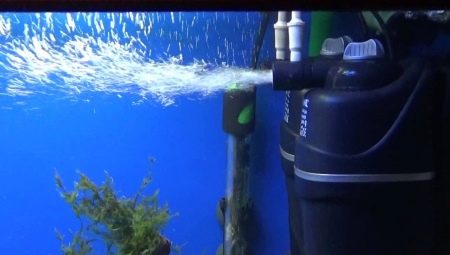Keeping aquarium fish at first glance seems like an extremely simple task - pets really do not need to walk or play with them, but they require the creation of special conditions. A modern aquarium is a complex technological design, each detail of which is of fundamental importance, and neglect of any of them is fraught with negative consequences for its inhabitants. An aquarium filter is one of the most important parts of the entire aquarium, and before you start fry, you should understand what it is and why.
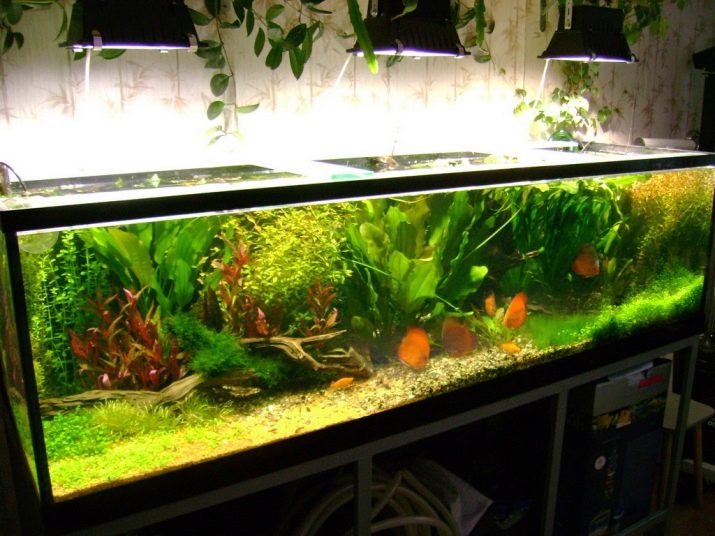
What is it and why are they needed?
Dirty water is a real scourge of our time, and if you have heard a little about a science such as ecology, you probably know that moisture flowing from a tap is potentially dangerous to health. Today it is extremely difficult to find good clean water. If some 100 years ago it was still possible to risk drinking water from a river or lake, today it is a real poison that provokes serious disorders of the gastrointestinal tract in humans and the extinction of fish. You could argue that there are still some inhabitants in our rivers, but keep in mind that in the aquarium you are unlikely to breed typical river perches and crucians, and the overseas beauty is used to completely different conditions. Filling a tank with tap water taken from a polluted reservoir and passed through rusty pipes, you risk ruining your fish in the very first days.
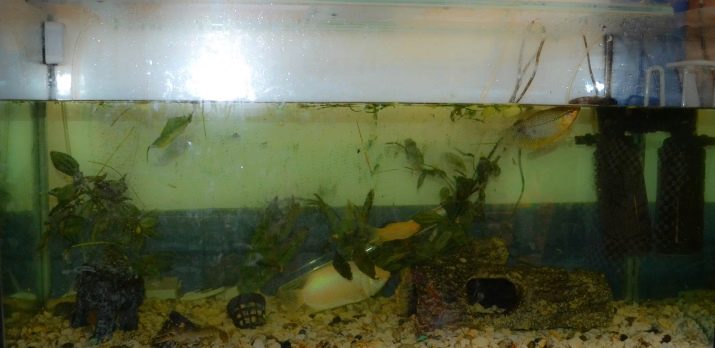
In fact, an aquarium water filter purifies water comprehensively, removing any type of impurities. First of all, of course, these are extraneous impurities that are initially present in the liquid.
In conditions of a closed and rather cramped space, a threat to the fish is represented by waste from their own life, and the filter successfully copes with the removal of this waste as well.
Among other things the abundant presence of oxygen in the water is important for the inhabitants, but if in fluid reservoirs moisture is quite easily saturated with direct contact, in a closed aquarium, and even indoors, this does not occur naturally. Most aquarium filters at the same time solve this problem by performing aeration and bringing water to a state that allows your pets to live with maximum comfort.
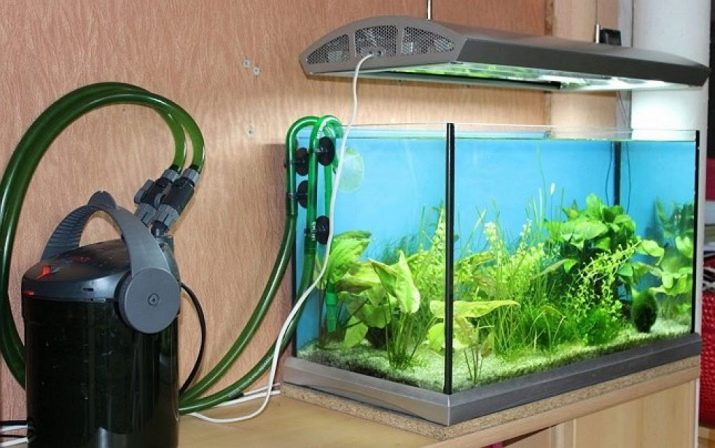
Principle of operation
There are several main varieties of aquarium filters, and each of them works according to its own scheme.
Airlift filters are based on the so-called jet pumpwhen the compressor pumps air under pressure into the bottom of a vertically mounted water pipe. Due to this, aeration of the liquid occurs, which, when mixed with air, becomes lighter than ordinary water, which is pressing from below, and thanks to this it rises along the tube. From there, it flows back into the aquarium, but at any of the ends of the tube, lower or upper, you can put filters that will filter out all the excess. Some craftsmen experiment with creating a filter of this type even on their own - they use either foam rubber or a layer of expanded clay or pumice with plants planted on top of them as a filter material.
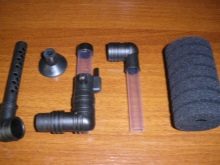

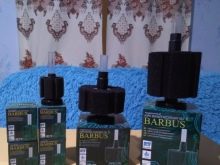
A device of this type is operated very simply, but it has a significant drawback in the form of low productivity and inability to work with large capacities.
The pump filter as a whole works on the same principle, only water is supplied to the filter layer not by air injection, but by means of a pump, that is, a pump pumping directly the liquid itself. Such devices are divided into internal and external, but the difference between them consists only in where exactly the block with the filtering material is located - in the water column or not. Structurally, such a mechanism is performed so that the pumped substance passes directly through the inside of the engine, at the same time cooling it and protecting it from possible overheating. In contrast to the airlift mechanism described above, this filter option works productively with almost any volume of water, therefore it can be used even in the conditions of the largest aquarium.
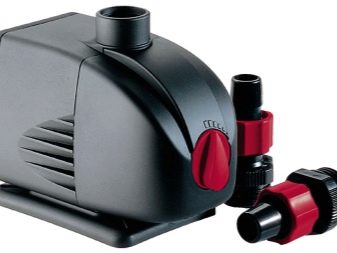
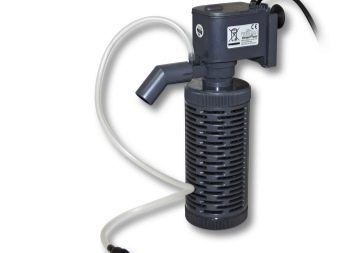
Varieties
The above options for organizing the filter device indicate only the general principle of the mechanism, while in fact the constructive variety of aquarium mechanisms is much greater. The species are so numerous that for a beginner it can be difficult to choose the optimal one - that’s why we’ll try to at least roughly understand what such devices are like.
The internal filter is a submersible mechanism, completely located under water. Such devices are the most common, since they are considered the cheapest both in terms of purchase price and maintenance costs. They are divided into the above-described varieties - pump-action and airlift, with aeration already provided. Despite the demand, it should be recognized obvious disadvantages - for example, the fact that the submersible structure occupies part of the volume of the aquarium, reducing its usable area.

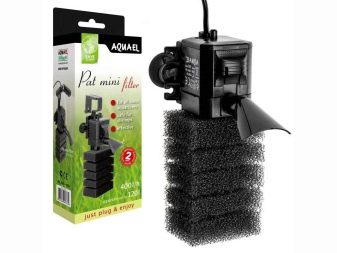
In addition, the mechanism must be removed once a week to clean the filter layer, and even such an assembly is characterized by significant noise during operation.
The external filter is of the pump-type type, since the liquid from the main tank must be supplied outside the aquarium. Water is supplied by a relatively weak stream and passes through several layers of filtration, while materials are usually used versatile - foam rubber, synthetic winterizer, coal, peat and much more. This mechanism is very quiet, and fillers rarely need replacing.However, there are some peculiarities - for example, cleaning filters is possible only in water drained from the aquarium, and replacement is only done gradually. Such precautions are caused by the fact that the filtration is largely provided by bacteria living in the layers, and the immediate replacement of all immediately leads to a violation of biological equilibrium in the existing system. This version of the device is usually in demand by avid and experienced aquarists.
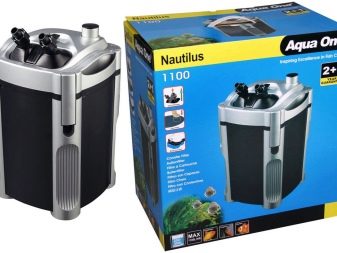
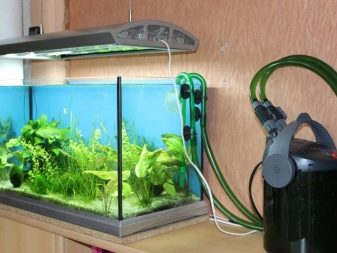
The so-called canister filter is also considered separately, but it, in fact, is no different from the already described external one - it is simply noticeably larger, since it is designed for significant volumes of a container with fish.

It does not have its own advantages and disadvantages compared to a “simple” external filter.
The bottom filter today can be considered a rarity, although previously it was used quite often. In fact, this is the same internal mechanism, but with a twist - it is disguised as false, which makes it seem like there is no filter at all in the aquarium. As the filtering material, the actual soil through which the pumped water passes can be used. Today, this option is considered relatively ineffective.
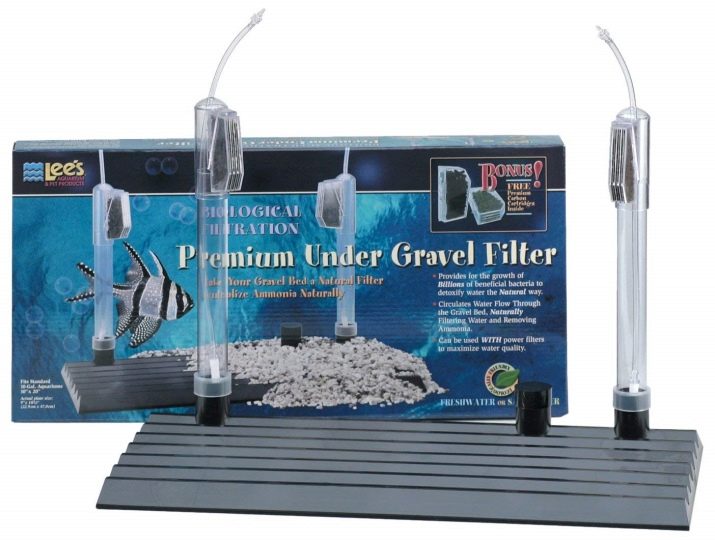
A relatively recent invention is the so-called Hamburg filter. In fact, it is a huge sponge, which divides the aquarium from the bottom to the surface into two parts, separating a small area from the main part.
The hinged “backpack” from this separated part constantly pumps water through the top into the main zone of the aquarium, creating a small waterfall.
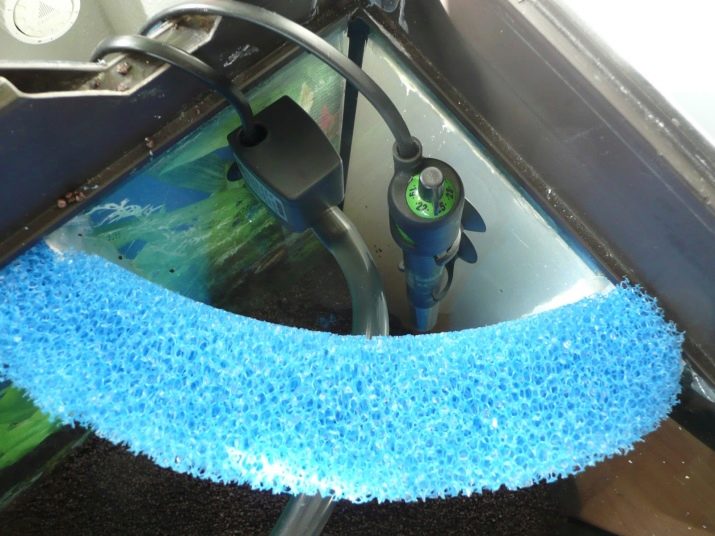
In this regard, the pressure in the smaller zone is always lower than in the larger one, because water from the latter begins to rush to the former, passing through the filter sponge. The creators of the device advertise it as very effective, since the laws of physics are used to a large extent to pump large volumes of water, and mud from the liquid does not clog narrow tubes - almost the entire section of the aquarium is accessible for its passage. The latter reason also determines that such a filter does not require special cleaning - it is included in the concept of general cleaning of the aquarium, and the large area of the filtering zone leads to the fact that replacement is rarely necessary.
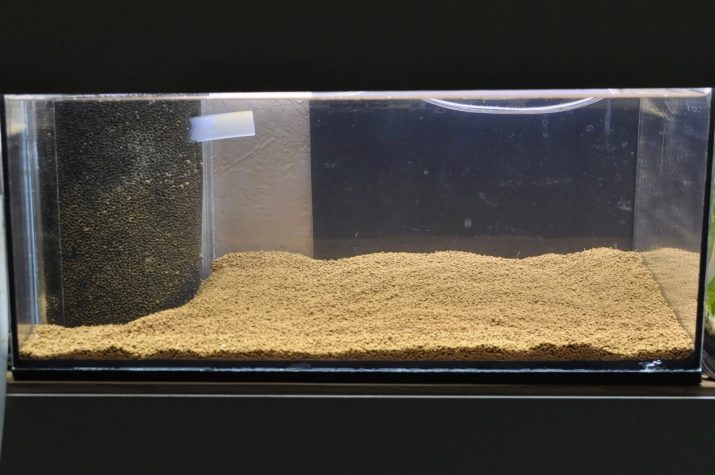
Types of Fillers
By purchasing a filter, each aquarist expects that the device will effectively cope with the tasks assigned to it and will make it possible to purify water as efficiently as possible. It is most reasonable to use mechanisms with several different filter layers, but even in this case, one should understand what kind of fillers are and what kind of result they give.
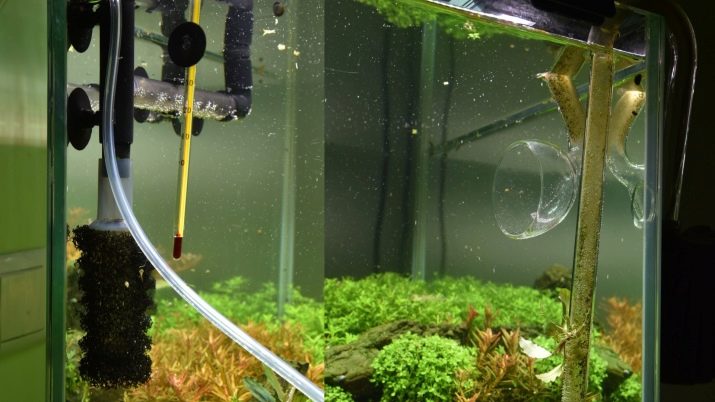
Foam sponge
The unequivocal top of our time is foam rubber, which passes water well, but retains dirt. Unlike competing synthetic winterizer, this material requires less frequent replacement, and it is also good because it is friendly to bacteria that can neutralize fish waste.
Today, a foam layer is present in almost any filter, and it is subject to maintenance approximately every two weeks.
It should be washed in water from the aquarium, otherwise all beneficial bacteria will be washed off into the sewer.
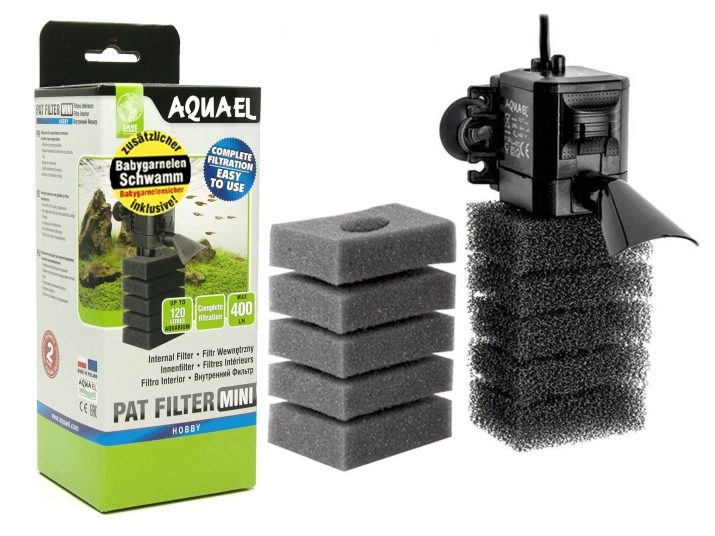
Ceramic Fillers
Ceramics are geared towards biological filtration, and only on it - the fact is that the porous structure of the material is very convenient for settling nitrifying bacteria there, and they help break down the toxic waste of fish activity. As in the case of foam rubber, ceramics are not washed under running water, preserving biological balance. Such an element is more often found in external filters, but if it is possible to place it in the internal structure, it is worth doing this.
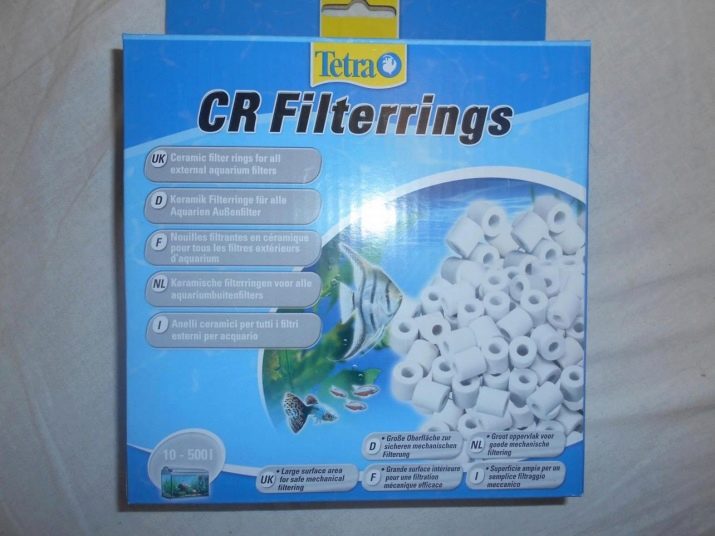
Synthetic winterizer
It was already mentioned above that this material clogs up pretty quickly, but this is its feature - it is very viscous and copes well with the mechanical cleaning function.
This layer is especially relevant after cleaning the aquarium, when a huge amount of the easiest suspension floats in the water - even it will not be able to pass through such protection.
“Vata” is not suitable for everyday filtration, since it turns into a dirty lump for a maximum of a week, and although it can be washed under running water, it is often used to eliminate strong turbidity of the water.
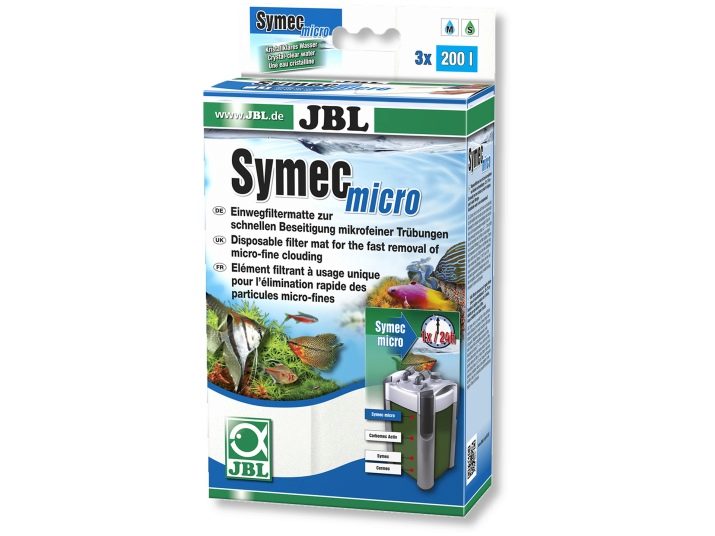
Zeolite
This ion-exchange resin is ideally suited for chemical cleaning of containers, since it literally attracts various poisons and harmful substances, acting approximately in the same way as a sorbent acts in the human body. Moreover, sometimes the potentially beneficial effect of such a substance also affects the necessary elements - the resin also absorbs phosphates, and it also lowers the pH level. It is possible and necessary to use such a filter element, just care should be taken to balance its small negative effect.

Expanded clay and volcanic lava
Another version of the filter material that contributes to the biological treatment of water. A big plus of expanded clay balls is that they are not only not contaminated by extraneous mechanical suspensions, but, in general, practically do not become clogged. The potential danger of using such a filter is that excess phosphates and silicates may be present in the substance, not to mention heavy metals, therefore, before use, the filler must be washed well.
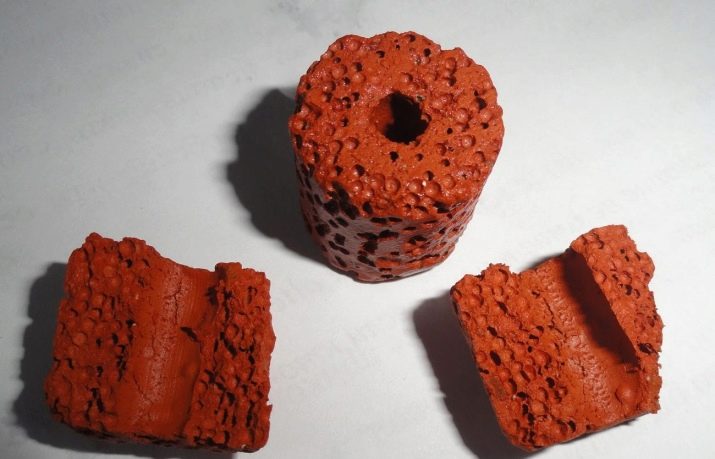
Carbon filler
To produce such a substance, it is not simple coal that is taken, but activated carbon - the very sorbent that can collect a lot of impurities that do not exactly contribute to the health of the inhabitants of the aquarium.
Such a substance does not have a specific service life - it all depends on the type of filtration.
For this reason coal is never used as a permanent or just the main filter material - it only supplements other filters when it is necessary to effectively purify water from excessive turbidity or after treating pets for any disease with the help of drugs added to the aquarium.
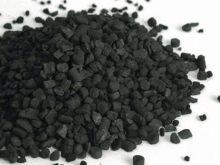
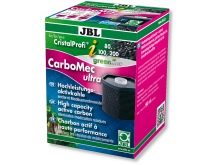
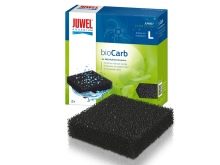
Peat
This natural element is often found in aquariums, but it is only relatively rarely used as a filler for the filter itself. It provides optimal conditions for those pets and plants.who like soft water, however, it should be remembered that not all fish like these living conditions.
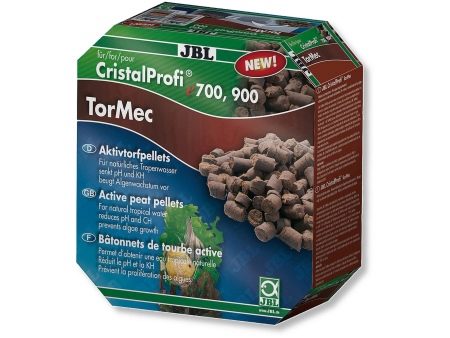
Popular models
The filter for the aquarium is a device that needs to be selected individually for each aquarium, taking into account, among other things, the specifics of the fish that live in it. Nonetheless there are certain models that are in stable demand by a large number of consumers, and for beginners who do not yet have a huge knowledge base on choosing a device, this may turn out to be a great hint. In addition, this is a definite guarantee that the purchased unit will be of high quality.
Please note that our list may be subjective - the choice of the majority does not always indicate that a particular model is the best for your conditions.
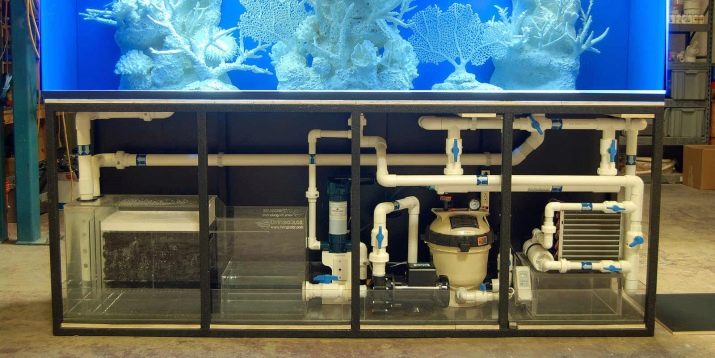
That is why we basically did not give out places on the list - we believe that each aquarist decides for himself what is more beneficial for his fish.
Recently, several models are considered top-end internal filters.
Eheim aquaball 180
This is a vivid example of how in one case there can be everything that underwater inhabitants need - there is a built-in diffuser and a spherical head that evenly distributes the flow of returned water throughout the tank. For the convenience of the owner, a water flow regulator is also provided. The unit provides for the use of several filters at once, and is especially practical in that it allows the detachment of some compartments for cleaning, while all the others work.
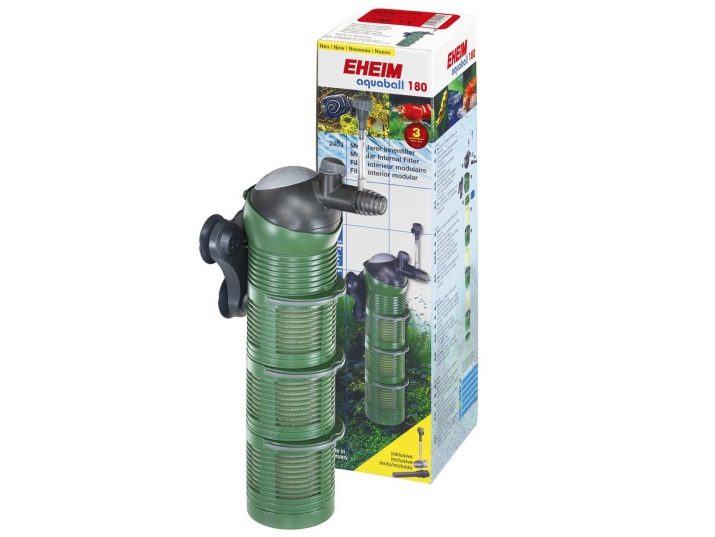
Tetra EasyCrystal FilterBox 600
The unit was created specifically for medium-sized aquariums in the range of 50-150 liters, but at the same time it drives water at a speed of 600 liters hourly, that is, it is distinguished by the ability to very effectively remove even the most complex contaminants from the water. This device provides cleaning in all three parameters - mechanical, chemical and biological, and it can also be combined with a temperature regulator, providing the perfect microclimate in the aquarium.
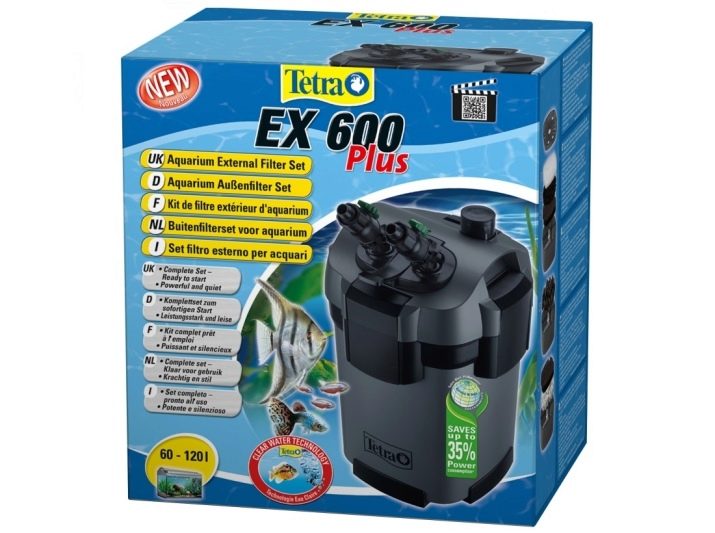
Juwel Bioflow 8.0
The Chinese mechanism has proved to be excellent in working with large-capacity aquariums - It is suitable for artificial reservoirs with a volume of 300-500 liters. He filters the water with a huge capacity of 1000 liters per hour, while he himself has an internal volume of 7 liters, which does not differ much from outdoor units.
For external filters, we created a separate list, taking into account a slightly different principle of operation.
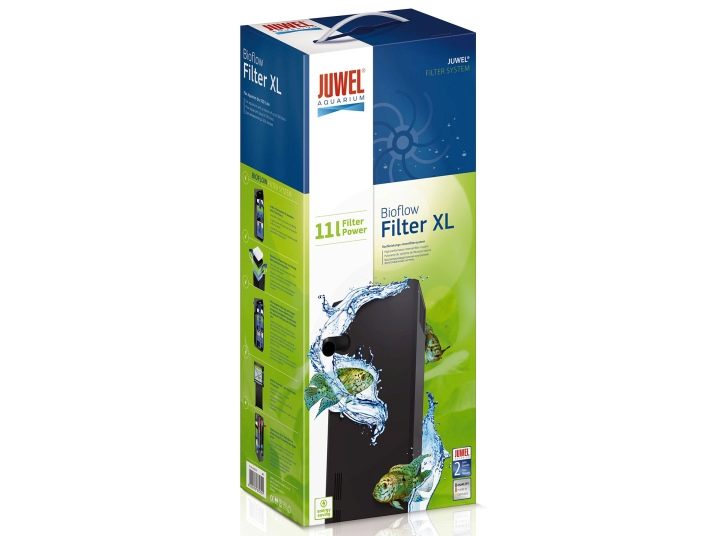
ADA Super Jet ES-1200
This unit does not make the impression of a typical "bucket", because its body is made of stainless steel and has a unique design style. The mechanism implements all the main types of liquid purification, and the productive pump is supplemented by design features that further increase the efficiency of the device.
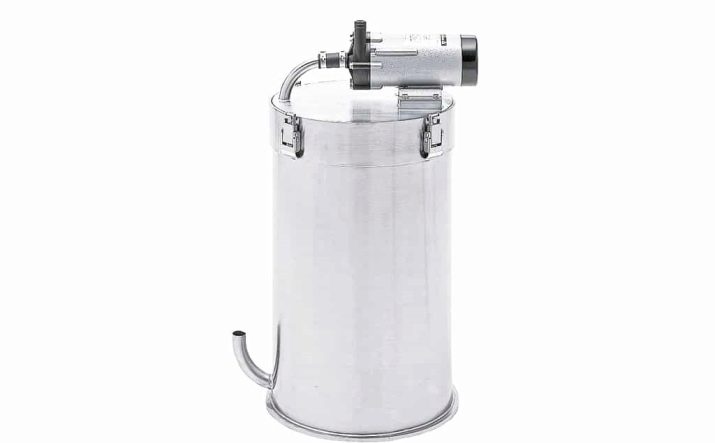
Aquael fan-1 plus
One of the most versatile filters for aquariums - it practically does not put forward requirements for the volume of the vessel, working with capacities from 20 to 300 liters. Consumers especially highlight the extremely simple installation and start-up of the unit, they also like the ability to independently determine the fillers for which 8 modules are provided.

JBL CristalProfi e702 greenline
This model is somewhat inferior in versatility to its counterpart above, but also gives room for maneuver - from 60 to 200 liters. When running water at a speed of up to 700 liters per hour, it consumes only 9 watts of electricity in the same time. Consumers are also highly regarded for their virtually silent operation.
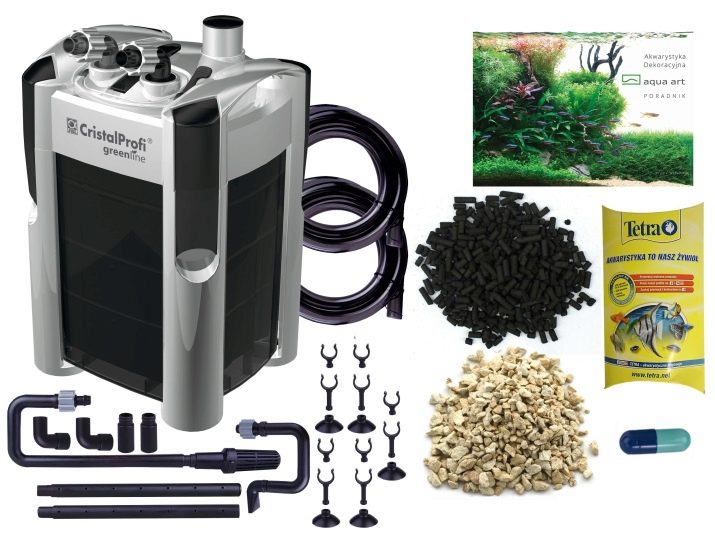
How to choose?
As you can see, each type of filter has its own advantages and disadvantages. Nevertheless, an inexperienced person does not always succeed in choosing the right unit, because a beginner often focuses only on the type of device, forgetting that it is necessary to evaluate other characteristics as well. Here's what you should pay attention to.
Potential aquarium volume
The effectiveness of each mechanism is designed for a specific displacement - it is naive to think that a unit oriented to a volume of 50 liters will cope with a 200 liter aquarium. When purchasing a mechanism, take an interest in what volume it is suitable for, and be sure to make a stock of at least 10 liters.
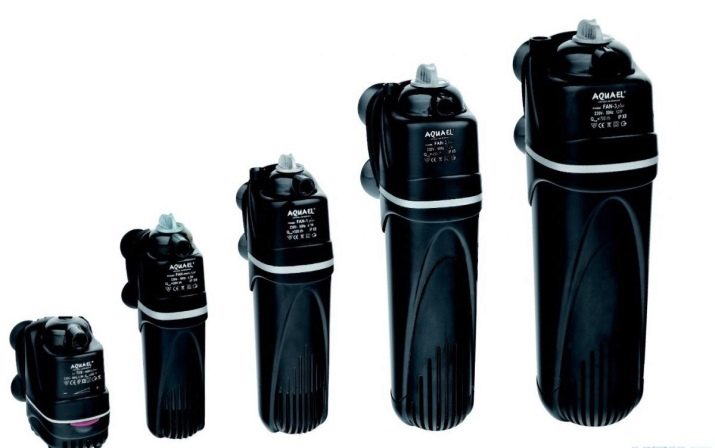
Performance
It is one thing how much water a filter can handle, and another is how long it will take. The most powerful and expensive models are able to pump 400-600 liters hourly through the filtration layers, which means that in a 100 liter aquarium, the entire volume of liquid will be cleaned several times in a row for just one hour.
Type of filtration
Above, we have already indirectly touched on this topic. Filtration can be different - mechanical filters out dirt and sand, biological breaks down the toxic waste products of fish, and chemical removes various impurities from the water that will not benefit the inhabitants of the artificial reservoir.
Type of filler
An entire section has been devoted to this issue, but just in case, it’s worth clarifying that some filters do not allow a variety of fillers - certain types of filter material cannot be used due to the design features of the unit. This answers the question of why you need to know what types of filtering the selected mechanism supports.

Energy consumption
A typical home filter for a small aquarium is powered by a wall outlet and consumes very little - at the level of 5-7 W hourly.Such an indicator is completely uncritical for any household, but you need to make sure that the powerful model you choose is also economical, otherwise the electricity bill can be shocking.
The need for cleaning and replacing the filter medium
There are no filters that do not require maintenance, but in such a situation, aquarists want the service to be as rare as possible, without affecting the efficiency of the device. The optimal choice is to choose a unit that needs to be cleaned about as often as the entire aquarium - It’s easier to take out all the procedures for one day.
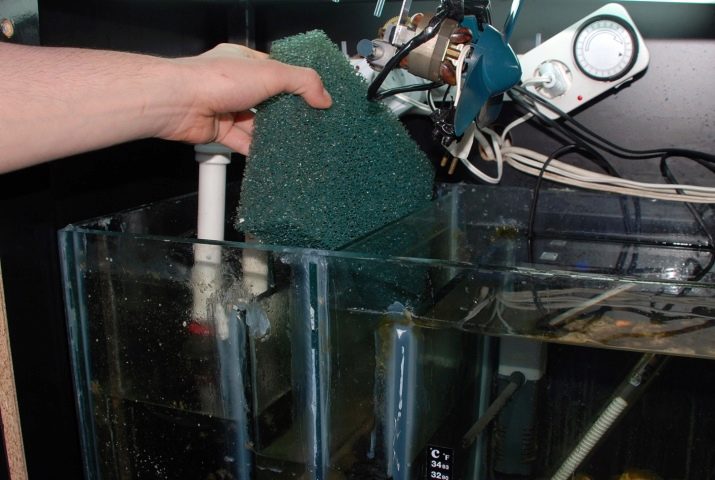
Outflow direction control
Water passing through the filter returns to the tank under pressure, which not all residents will like - some of them like a calm atmosphere without a current. For a mini aquarium up to 30 liters, this could be a real problem., because the jets can’t hide anywhere, and it turns out that it takes up the useful space of the vessel. That is why the designers came up with a fan mode of water injection, when it is evenly distributed throughout the aquarium.
Noisiness
In the apartment where you and your household live, silence can be fundamental, because the noise of a working filter interferes with sleep, especially if there is a small child in the house. For this reason, it is worthwhile to ask how noisy the operation of the device is, and special attention should be paid to silent external units.
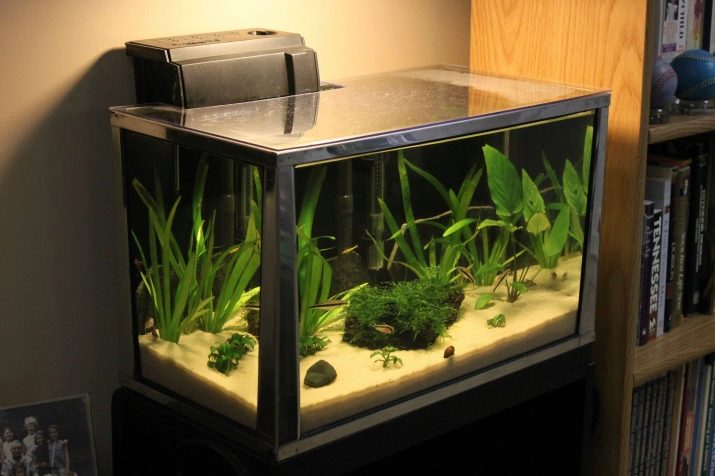
How to install?
Manufacturers usually supply their products with installation instructions, but for a beginner it can be difficult to immediately understand it. To avoid mistakes, consider what and how to do it.
Remember that the filter is never installed in an empty aquarium - even during installation you are guided by the water level. If you purchased the unit unassembled, be sure to dry it thoroughly before assembly - it is reliably isolated from moisture, but if it is inside, an electric device can teach you a good physics lesson.
The depth of 3 centimeters is considered to be the optimal place for the internal filter - this level allows it not to appear on the surface even with increasing temperature and heavy evaporation of aquarium moisture.

At the same time, it is inadmissible for the appliance to touch the bottom - in no case does it lie on the ground, but is attached by suction cups to the wall of the vessel. Try to get such a device that normally fits into the dimensions of your artificial reservoir, otherwise you will have to add more water or deepen the bottom.
When determining the location for the device inside the aquarium, do not forget to check the length of the power cord. The cable should be enough so that it hangs freely from the power source and to the case itself, otherwise the tension increases the likelihood that the cord will wear out or be accidentally pulled out of the outlet. A filter that has been idle for a long time can be a huge problem for fish who experience a sharp deterioration in their living conditions.
Naturally, the device is immersed in water in the off state - at least so that the water jet does not interfere with you to properly fix the device on the wall.
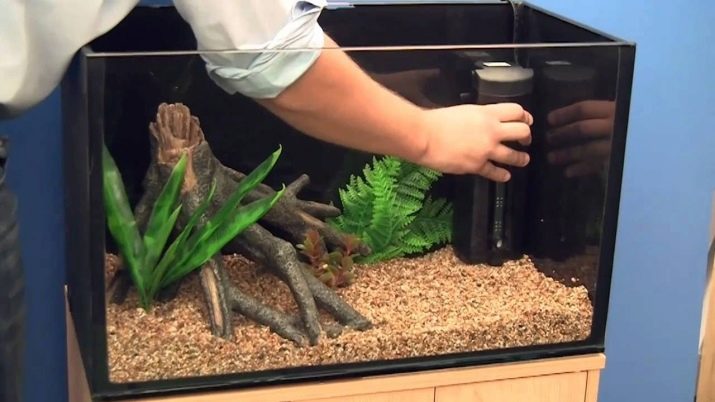
If the filter has a separate air intake pipe, it must be brought out and in some way given a reliable and stable position to ensure that it does not fall into the water. For this reason, it is worth initially choosing filters where a fixture is provided on the aerator tube that is convenient for the conditions of your apartment.
When all the instructions are completed, it remains only to plug in the power outlet. If there is a flow inside the aquarium, it means that the engine is working, and water is passed through the filtration layers.

Just note that the above steps are average recommendations for most submersible devices, however, some models may have slightly different recommendations. This means that our tooltip does not save you from having to consult the instructions. Other types of mechanisms may have a different installation scheme, and although it is always simpler, the instructions should also be read before something goes wrong.
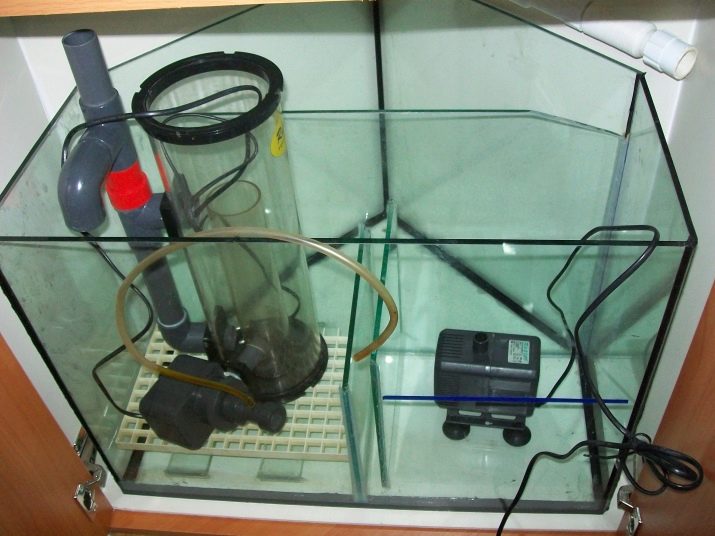
Terms of use
Using a filter to purify water requires compliance with rules that seem simple to most experienced aquarists, but can be a real discovery for beginners. For this reason, we consider what is worth doing and what is unacceptable during operation.
- Regular cleaning of the filters is mandatory, since none of them is eternal. The frequency of such a procedure depends on which filler you have chosen, and what type of machine your device is. But the terms prescribed in the instructions must be strictly observed, otherwise the water in the aquarium will not be cleaned.
- Water filtration should be continuous. If you suddenly need to disconnect the mechanism from the power supply, immediately remove it from the aquarium. Remember that the dirt accumulated by filtering materials does not return to the water, largely because the filter does not let it go forward, but the flow backwards. Leaving the appliance turned off in the water will allow the waste accumulated over time to fall into the liquid at once.
- Safety precautions do not allow your hands to be lowered into the water while the filter is on. You can’t expect that if everything is in order with the fish, then nothing will happen to you either. By the same logic, the extraction of a mechanism for which you will definitely have to lower your hands into the water and mess with suction cups is prohibited at the moment when any other electrical aquarium life support devices are not turned off.
- The submersible unit is switched on only after it is completely immersed in the water column. Otherwise, air may enter the system, which does not contribute to the proper operation of the device.
Which is better - an internal or external filter for the aquarium, see below.
